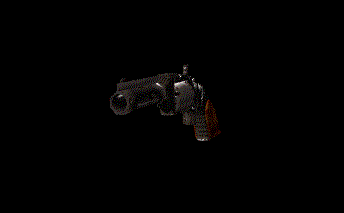|
Module 50 |
Updated: 08/13/2005 |
|
Continuity
The above statement was made in 1915. Since that time editing has become even more important. Editing establishes the structure and content of the production along with the production's overall mood, intensity, and tempo. In this series of modules on editing we'll start with the most logical and useful approach: continuity editing. Continuity editing refers to arranging the sequence of shots to suggest a progression of events. Given the same shots, an editor can suggest many different scenarios. Consider just these two shots. |
|
In this order it appears that the first man was shot. However, if you reverse the order of these two scenes, the first man is watching a shooting. Let's look at what we can do with just three shots.
1-2-3 - In the 1-2-3 sequence shown the shots suggest that people are jumping from a car seconds before it catches fire and explodes. 3-2-1 - A 3-2-1 order suggests that there is an explosion and then the car bursts into flames; and, as a result, the people have to jump out. 2-3-1 - In a 2-3-1 sequence people jump from the car after a fire causes an explosion. 2-1-3 - If the sequence is changed to 2-1-3, it appears that as a result of a fire passengers jump out of the car just in time to escape a devastating explosion. Three shots; very different meanings! When hundreds of scenes and takes of scenes are available to an editor, which is normally the case in dramatic productions, the editor has tremendous control over the basic continuity and message of the production. |
|
Changing Expected Continuity Continuity editing primarily suggests guiding an audience through a sequence of events and, in the process, showing them what they want to see when they want to see it. In the end, you've told a story or logically traced a series of events to their conclusion. In dramatic television good editors sometimes break from the expected to achieve a dramatic effect. Unfulfilled expectations can be used to create audience tension. Let's take this simple shot sequence:
Why? We don't know. Where is the shot of who or what just came in? What happens if we don't cut to that expected shot? The audience is then just left hanging with curiosity and apprehension-or, depending on how it's handled, with frustration and resentment. Here's an example of the latter. In a story about the changes in the U.S. $100 bill a treasury spokesperson spends considerable time giving specific details on the changes that were necessary to foil counterfeiting. Let's assume that the whole time all we see is a two-shot of the men carefully examining one of the new $100 bills. Obviously, we would want to see a closeup of the bill so we can see the changes they're talking about. If there is no such shot, we feel frustrated. So, unless you want to leave your audience hanging for momentary dramatic effect, always keep in mind what you think the audience expects to see at any given moment. If you do, your edit decision list (sequence of edits) will largely write itself. In news and documentary work the more logically your can present events (without extraneous material) the less room there will be for misunderstanding or frustration. In these types of productions you want to be as clear and concrete as possible. In dramatic production we have much more creative latitude. In fact, with dramatic productions it's often desirable to leave some things open for interpretation. Sometimes for dramatic effect and to keep an audience guessing (for a while) you may want to use editing to intentionally delay answering an obvious question. For example, at the end of the film, One Night Stand, director-writer-producer Mike Figgis focuses on the two main couples in the film, but keeps us guessing about who ends up with whom. The dialogue keeps you guessing, and there are two-shots showing each man with each woman. It is only at the very end of the sequence that the question is answered. (By the way, the director's narration included with the R-rated DVD version provides informative scene-by-scene commentary on the production and acting.)
In film and video production time is routinely condensed and expanded. For example, let's say you want to tell the story of a young woman going out on an important date. The process of just watching her pick out clothes from her closet, take a shower, dry her hair, do her nails, put on her clothes and make-up, check the whole effect in a mirror, make any necessary adjustments, and then drive to some prearranged place could take 90 minutes. That's the total time devoted to most feature films-and the interesting part hasn't even started yet! Very early in the film
business audiences were taught to assume things not shown. For example, the 90 minutes
or so it took the woman to meet her date could be shown in 19 seconds.
Or how about this.
Occasionally, an editor or director will want to drag out a happening beyond the actual time represented. The noted director, Alfred Hitchcock, (North By Northwest, Psycho, etc.) used the example of a scene where a group of people sitting around a dinner table was blown up by a time bomb. In a real-time version of the scene, the people sit down at the table and the bomb goes off. End of people; end of scene. But Hitchcock was famous for suspense, and no real suspense would be generated by this approach. In a second version the people gather, talk, and casually sit down at the dinner table. A shot of the bomb ticking away under the table is shown revealing to the audience what is about to happen. Unaware of the bomb, the people continue their banal conversations. Closer shots of the bomb are then intercut with the guests laughing and enjoying dinner. The intercutting continues (and speeds up) until the bomb finally blows the dinner party to bits. The latter version understandably creates far more of an emotional impact. Often, a part of continuity editing is to suggest or explain cause. A good script (enhanced by good editing) suggests or explains why things happen. For example, in a dramatic production it would seem strange to cut to a shot of someone answering the phone unless we had heard the phone ring. A ringing phone brings about a response; the phone is answered. We may see a female corpse on the living room floor during the first five minutes of a dramatic film, but not know who killed her or why until 90 minutes later. In this case effect precedes cause. Although strict continuity editing would dictate that we present events in a logical sequence, it would make a more interesting story-one that would be more likely to hold an audience-if we present the result first and reveal the cause gradually over time. Is this not the approach of almost every crime story? Sometimes we assume cause. If we are shown a shot of someone with all the signs of being
drunk (effect), we can probably safely assume they have If we see a shot of someone attempting a difficult feat on skis for the first time, followed by a shot of them arriving back home with one leg in a cast, we assume that things didn't quite work out. Let's go back to the corpse on the living room floor. Knowing
that the husband did it may not be enough (maybe for the police, but not for most
viewers). In causality there is also the question of why. This brings up
motivation. Motivation Under motivation, we can assume any one of the age-old motives, including money, jealousy and revenge. But, even knowing that the motive was revenge may not be enough for a well thought-out, satisfying production. Revenge must have a cause. To provide that answer we may have to take the viewer back to incidents in the past. We could show a woman with a string of lovers. We could then see suspicion, jealousy, resentment, and anger building in her husband. Finally, we could see that these negative emotions could no longer be restrained. Now we understand. We've been shown effect, cause, and motivation. Editors must perceive the dynamics of these cause-and-effect relationships to skillfully handle them. They must also have an understanding of human psychology so that they can portray feelings and events realistically. How many serious dramatic productions have you seen where actions and reactions just don't seem to be realistic? Does this not take away from the credibility of the production? Writers and directors also know they shouldn't reveal answers (motivations) too quickly. In a good mystery we will probably try to hold our audience by leading them through critical developments in a step-by-step fashion. Note: Today's video and audio editing systems are almost all based on computer platforms. If you need a refresher course on the essential computer basics, click here. |



 been
drinking (cause).
been
drinking (cause).